The erection of your own home is an important and responsible business, in which there are no trifles. It is rather difficult to think over and calculate every detail, but the main and vital points must be planned in advance, even at the design stage.
One of such cases will be the choice of the main load-bearing elements - slabs, which are used not only for multi-storey construction. What are the types of overlapping, the main dimensions and methods of insulation, as well as possible options overlapping in wooden houses - all the information in our article.
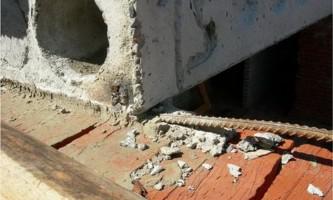
Of course, first of all, these elements are distinguished according to the type of destination, the material used and the configuration. An overview of each indicator and the main criteria for selecting suitable overlaps are discussed below.
Benefits
- Affordable cost.
- Relatively light weight.
- Opportunity self-assembly without the involvement of special equipment and additional workers.
- Quick installation.
- A wide choice and possibility of manufacturing under the order.
On video overlaps between floors in a private house:
Plates overlap marking and dimensions are indicated
Among the shortcomings most characteristic for wood: decay, destruction under the influence of fungus, insect pests, fire hazard and aging. That is why before installation different compositions for processing are used. They will give the wood extra strength, fire resistance and resistance to bacteriological attacks. In addition, the places of contact with stone and metal surfaces should be wrapped with a roofing material to create the necessary waterproofing. For the same purpose, a mounting foam can be used.
Metal
There are different types of configurations: corner, channel and I-beam. All of them are designed for different loads, but unlike wooden ones they take up less space, are more economical and more durable. The overlapping span can be up to six meters. Advantages: fire resistance, pests and decay are not terrible. From lacks it is possible to note absence of heat and sound insulation. To fix this, you can wrap the ends of the beams with felt, but usually this is ineffective. 
As the slabs for metal beams used wooden boards or lightweight concrete, which is poured into the formwork. The second method is too time-consuming and is used in very exceptional cases.
How the slab of pc 15 is used is available in this
Reinforced concrete beams
Concrete structures are able to block spans from 3 to 7.5 meters. The laying frequency is not less than 60 centimeters. The distance between the beams is filled with concrete solutions and hollow blocks. 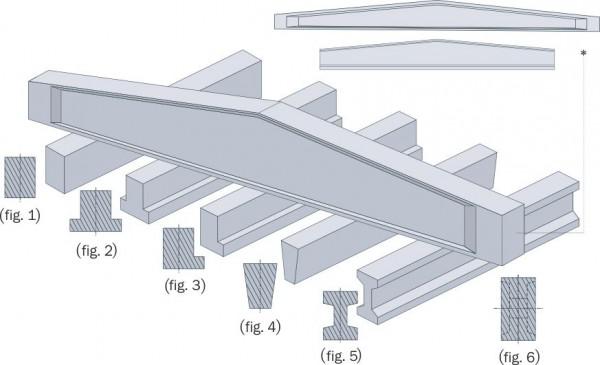
There are two positive moments:
- Overlaps a wider distance than metallic and wooden ceilings.
- No additional sound insulation and pest protection is required.
The negative side: it is difficult to establish such a beam, it requires the involvement of specialized equipment, which means an increase in costs.
Usually this cast-in-place slabs, in which there are no clearly defined configurations, otherwise they are also called bezbalochnymi. Most often, reinforced concrete hollow panels or solid slabs of lightweight concrete are used.
Multiple hollow core slabs series 1.141 1 is used exactly as indicated
Benefits
- High strength.
- Withstand a load of more than 200 kg / m².
- Are not subject to rotting and spoilage by pests.
The disadvantages will be the need to attract special equipment for installation, as well as the standard dimensions of the plates when planning a house. Some businesses can make slabs on order, but this is also an additional cost. Also for the installation of slabs a fairly solid foundation and a wall thickness of at least 25 cm is needed. Slots between the slabs must be sealed with cement.
Monolithic
If the building configuration does not allow the use of standard prefabricated plates, you can choose the next option - pouring a reinforced concrete structure on its own. This process is labor-intensive and long-lasting, but efforts will be repaid in a hundredfold thanks to a long service life and strength characteristics. ![]()
For this, it is necessary to install load-bearing beams, formwork and reinforcement system. The entire structure is poured with concrete, for which cement grade 200 or higher is used. The plate lasts at least 28 days until it is completely solidified. Pouring is carried out immediately, this requires at least a concrete mixer of a decent volume, ideally it is better to purchase a ready solution in necessary quantity. As a rule, for a bearing capacity, a layer of concrete from 10 to 30 cm is enough.
About what the size of the bar can be used when the house is closed, described in this
Prefabricated - monolithic
An improved version of the previous version, where the floor slabs are used hollow blocks, they are poured on top of the concrete layers. Advantages will be easier installation and good quality coating. Thanks to such designs, it is possible to implement any possible architectural projects. The disadvantage is the time-consuming process of stacking and transporting blocks. 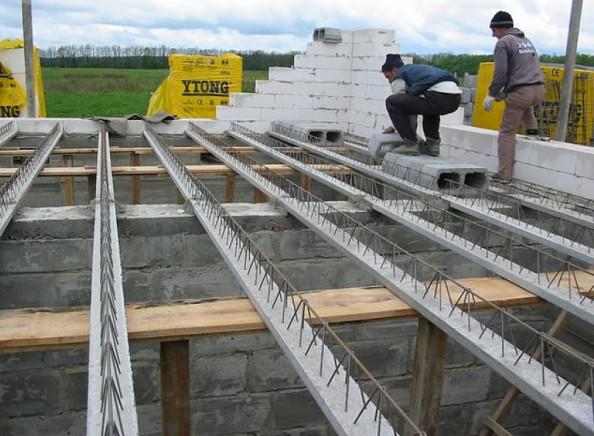
How to insulate floors
- The optimal solution is the purchase of ready-made mineral wool slabs.
- The lower layer is made from the linen of the roofing material, topped with clay (mixed with sand), slag and wood sawdust.
- Special wood boards from wooden sawdust and concrete. They can be purchased ready, but you can do it yourself. For this, 0.3 parts of cement mortar, 4 parts of clay, 1.5 lime and 2 parts of water are used for one part of the sawdust. Plates form the given sizes, a little podsushivajut and use as a thermal protection.
The video tells how to insulate the floor between floors in a private house:
Plates of overlapping of the modern assortment open wide opportunities for individual construction. Thanks to many options it is possible to implement the most unexpected architectural designs and ideas. When building buildings, it is possible to combine and modify existing types of load-bearing structures, above all, be guided by the basic safety rules.
The overlapping of various sizes is an important element of any structure. Dependence of the strength of the house, so you need to choose materials for construction carefully. Even if the object is single-storey, without overlapping the basement is indispensable. The most reliable and cost-effective option for solving such problems were and still are concrete slabs.
In Moscow, more than a hundred firms offer to buy products of factories of reinforced concrete products. Some of them are directly producers. These are various joint-stock companies based on existing factories (reinforced concrete products No. 5, No. 21, Mospromzhelezobeton and others).
There are a minority of such companies, only a few dozen, but it is up to them to place an order. Other firms are intermediaries or sellers of used panels. The range offered is usually small, and it will not be easy to find the required size at an affordable price.
Concrete and reinforced concrete slabs are produced by the factory of concrete products in series on rather complicated equipment. Although mandatory certification of such structures is canceled, most manufacturers continue to work in accordance with the requirements of GOST. That is why the types and sizes of products are unified - there are no non-standard solutions. So, during construction it is necessary to plan in advance which overlaps will be used.
1. Full bodies (PTS).
Are made in the form of a continuous monolith with a metal reinforcement inside. The weight of the PTS is very large (up to 7 tons), which must be taken into account when calculating the load on the foundation, but this disadvantage outweighs the high strength. They are used in capital construction and in the construction of multi-storey buildings.
The marking of solid plates consists of two parts. The index indicates the thickness of the monolith:
The letter designates the plates according to the type of support on the bearing walls:
- PD - on 2 sides (produced in thickness 2PD-6PD);
- PT - on 3 sides (only 3PT-6PT);
- P - along the entire contour (in all sizes).
In the free sale there are supplementary solid boards of concrete PTVV (new and used) with a standard width of 39 cm and a length of up to 7 m. They are used when the total width is insufficient to cover the required area.
| Make | Length, mm | Weight, kg | Price, rubles |
| PTVV-24-4 | 2 390 | 480 | 1 620 |
| 26-4 | 2 590 | 522 | 1 760 |
| 28-4 | 2 790 | 562 | 1 890 |
| 30-4 | 2 990 | 602 | 2 020 |
| 32-4 | 3 190 | 642 | 2 160 |
| 34-4 | 3 390 | 682 | 2 280 |
| 36-4 | 3 590 | 722 | 2 420 |
| 40-4 | 3 990 | 802 | 2 650 |
After the letter designation, the dimensions of the concrete slabs in decimetres are indicated: first the length of the panel rounded to the whole, and the width through the hyphen or point. The third digit - permissible load on the overlap, reduced to the centners per m2.
For solid boards in the marking, according to the current GOST 12767-94, the last class of applied reinforcement is indicated. Additional alphabetic indices mean other characteristics of reinforced concrete: frost resistance (m), use of lightweight concrete (l), seismic stability (s), embedded parts,

2. Hollow (PTM).
Lightweight products weighing up to 3 tons with through voids of round or oval cross section. They are in demand from private developers, so factories produce them in a large assortment. In addition to the relatively low weight, they are distinguished by even surfaces for finishing, which makes it possible to widely apply PTM when creating floor-to-ceiling concrete floors in residential construction. Additional heat and noise insulation properties also speak in favor of PTM.
The standard PC-type plates by type of support are two-sided. Three- and four-sided have an additional prefix to the letter designation "T" and "K" respectively. Their length is 4790 - 6950 mm, and the width is in the range from 1040 to 2420.
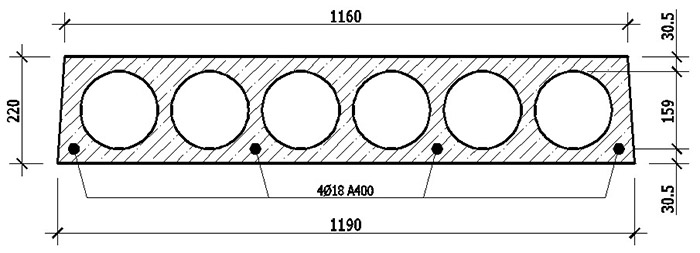

Depending on the parameters of a concrete slab, it can be classified according to the characteristics of voids in concrete. With a certain diameter of the holes, products of different thicknesses are assigned their own index from 1 to 7.
| Thickness - 220 mm | 260 mm | 300 mm | |||||
| Diameter of voids, mm | Make | Diameter of voids, mm | Make | Diameter of voids, mm | Make | ||
| 159 | 1PK | 159 | 4PK | 203 | 6PK | ||
| 140 | 2PK | 180 | 5PK | 160 mm | |||
| 127 | 3PK | Ellipsoidal | NG | 114 | 7PK | ||
A round-holed PB 260 mm with holes of 159 mm stands alone. Its difference is due to a different production technology - without the use of formwork. This overlap in the process of continuous molding of concrete in the factory can immediately cut into size. In this case, the width is selected from a number of standard values from 1 to 1.8 m.
Lightweight products are allowed to be used in the construction of houses of no more than 2-3 floors. Thick metal reinforcement in the concrete body is located only along the perimeter, and the surfaces are reinforced with a thinner steel wire. In this regard, the strength of hollow species is lower than that of monolithic concrete with full reinforcement.

The cost of hollow plates with a width of 1.5 m (1490 mm):
| Make | Length, mm | Weight, t | Price, rubles |
| PC 21-15-8 | 2080 | 0,97 | 4 060 |
| 30-15-8 | 2980 | 1,425 | 4 230 |
| 38-15-8 | 3780 | 1,75 | 6 240 |
| 48-15-8 | 4780 | 2,25 | 6 650 |
| 60-15-8 | 5980 | 2,8 | 7 400 |
| 70-15-8 | 6980 | 3,27 | 11 160 |
| 80-15-8 | 7980 | 3,73 | 18 410 |
| 90-15-8 | 8980 | 4,19 | 19 770 |
3. Ribbed (PTR).
U-shaped slabs of concrete refer to full-bodied products, but differ in cross-sectional shape and high strength. In fact, it is a system of beams, the gaps between which are filled with concrete.
As a result of this manufacturing technology, concrete slabs of MFD acquire additional stiffeners allowing them to withstand the highest mechanical stresses on bending and even seismic activity. Mostly used for the construction of flat roofs of industrial objects (hangars, warehouses, garage boxes), as for private construction they are expensive and not suitable for finishing.
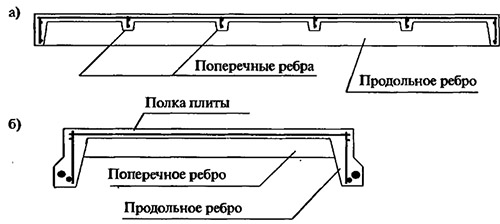
For ribbed concrete slabs, there are two types of installation:
- with the support on the shelves of crossbars (1P);
- with the installation on the top of the beam support (2P).
The first type is produced in length 5050 or 5550 mm and width in the plan from 740 to 2985. The second has only one standard size - 5950х1485 mm.
4. Plates of overlapping chambers (VP).
They are used to cover wells, trenches, heat chambers and collectors as a protection of mechanical units and communications located in them. These products are small in size, a maximum of 5 m 2, but with a wide choice of thicknesses from 16 to 36 cm. Concrete slabs of overlapping chambers can be either solid or hollow, with one or two hatches or even without them.

Standard dimensions
When designing a future house project, it is worthwhile to check the dimensions of the slabs at the nearest concrete plant and to calculate the overlap based on what the manufacturer can offer. This is the most suitable option, if you need to reduce the cost of construction, not at the expense of quality. It's easier to fix something in the project of the future house, than to try to adjust the overlap to the finished box.
Otherwise, you will have to buy additional elements of PTVV or at all order the production of a limited batch of slabs of concrete. The most expensive is a large hipped roof, covering the entire floor entirely.
1. The length varies in the range of 1.6-12.0 m. Depending on their technical equipment, one of the manufacturers also offers 15-meter concrete products. However, in construction, overlaps of an average length of 3.6-7.2 m are more often needed - they are produced in large volumes, so the cost is optimal.
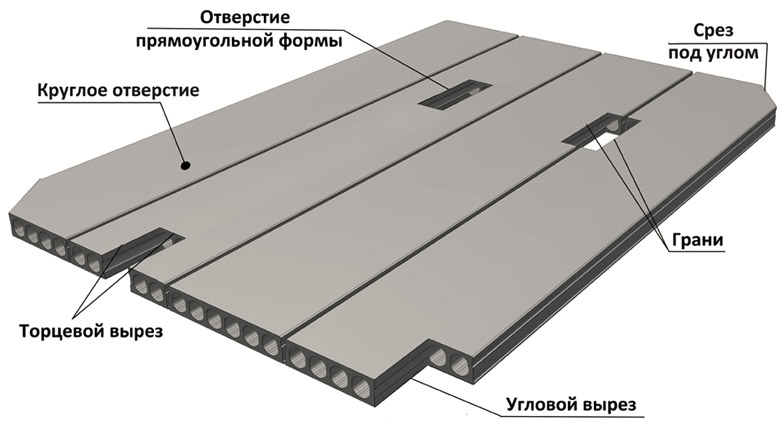
2. The width options are much smaller - only 5 possible sizes from 0.6 to 2.4 m, and those will not always be found. More often manufacturers are limited to two or three standard sizes: 1 m (990 mm), 1,2 (1190) and 1,5 (1490). This is enough to fit the overlapping of the required width.
Tip: For a typical object, it is cheaper to buy 4 slabs of 1.5 m thick than 6 meter slabs.
3. The thickness of the majority is standard - 22 cm. The differences are regulated by separate GOSTs for each type of overlap.
Products with the same size significantly differ in their characteristics. The influence on the operational properties is exerted by a large number of factors:
- The concrete grade (from M150 for low-rise construction to the capital M500) and its special qualities - moisture resistance, frost resistance, etc.
- The class and diameter of the reinforcement used are in the range of 12-22 mm.
- Density of concrete reinforcement.
- Manufacturing technology (with or without prestressing of the armature).
- Features of the design (the presence of mounting loops, slotted side grooves or hatches).
Depending on the combination of these properties with the sizes, the cost of the plates also changes.
Features of pricing
The prices of products made of concrete, produced serially in the iron ore plant, can be called quite democratic. Although it all depends on the size and characteristics of the material. However, their specificity is such that in the estimate it is necessary to include the cost of both the plates themselves and their delivery. The farther from the construction site of concrete products, the more expensive the purchase will be.
Well save those who can be in the suburbs. There are also a lot of operating construction plants that produce reinforced concrete products, but their prices are slightly lower than in Moscow.
Used products will cost cheaper, but not enough to afford the risk. First, when buying them, you need to choose only those concrete slabs that have no visible damage. Secondly, it should be remembered that the steel bars of the armature have their own term of metal fatigue.
To separate the floors of high-rise buildings, reinforced concrete slabs are used. For the lower floor, they serve as the basis of the ceiling, and for the upper floor - the basis of the floor.
Therefore, adherence to the quality of slabs serves as an important and responsible aspect of production, in which only high-class concrete is used, as well as conventional or stressed reinforcement. This ensures reliability, durability and long life of the products.
Reinforced concrete slabs
By design features concrete slabs PC overlap are divided into solid (monolithic) and hollow. Each type of slab is used in buildings of a certain purpose and specified operating conditions.
Monolithic slabs are defined by three types.
1. Ribbed slabs of overlap. The construction consists of beams that intersect each other. Formed by crossing empty areas are poured with concrete. Thus, these plates are ready to withstand sufficiently large loads. Therefore, their use is most often justified in the construction of industrial and commercial facilities.
2. Coffered slabs overlapping. This type is similar to the previous one in terms of design, high load capacity and application. The difference is only in the smaller thickness of the concrete layer, which is filled between the beams. Coffered slabs are also not used in the construction of residential and private houses.
3. No-girder slabs overlap. The design is defined by a flat, monolithic slab without the use of beams. The supports for them serve as walls and columns. These plates are used in civil engineering. Smooth surface of the plates eliminates the need for installation suspended ceilings.
All monolithic slabs are characterized by high strength values, so that they do not deform or sag.
Disadvantages are such parameters as very high weight, high coefficient of thermal conductivity, weak sound insulation. Void plates can easily cope with them. Hollow core slabs differ in shape, dimensions and diameter of internal voids. Depending on these indicators, 15 types of hollow plates, each with its own marking, are distinguished.
Unlike monolithic hollow core slabs have much lower thermal conductivity and greater sound insulation due to structural voids inside. In addition, the economic efficiency of hollow core slabs is also more justified by reducing the cost of production, saving heat inside the building and reducing the requirements for the parameters of the bearing structure of the house.
Additional advantages of hollow reinforced concrete boards of slabs from the manufacturer are the reliability of the construction provided by the factory production conditions, low cost of installation and high speed of installation.
Dimensions of slabs
The dimensions of the monolithic slabs are determined by the building structural characteristics of the building and can be completely different. Their feature is that they can be manufactured right on the site.
For hollow concrete slabs, dimensions are defined by length, width and thickness (height).
The thickness of the slab plate takes the standard value of 22 cm. It is rare to produce slabs with a height of 16 cm. The difference is provided by the diameter of the voids.
The length of the floor slab varies from 2 to 12 m. Most often at the design stage, slabs 3,6 - 7,2 m are used. They are considered standard.
Non-standard sizes lead to an increase in value.
The width of the slab is standard: 1.0 m; 1.2 m; 1.5 m; 1.8 m. It should be noted that slabs with a width of 1.0 m and 1.8 m are considered to be rarer and have a higher cost. Therefore, it is advisable to lay slabs 1.2 m wide or 1.5 m wide when designing.
The weight of the floor slab depends on its type and overall dimensions and can take values from a fairly wide range.
Load of slabs
When determining the slabs, it is necessary to take into account the static and dynamic load on the slab.
Static loading is understood to mean everything that loads the plate without moving relative to it. Everything that is subject to displacement is considered a dynamic load.
In addition, the load can be distributed evenly or unevenly, concentrated, etc. But in calculations of floor slabs for a residential house, only uniformly distributed loads are taken into account.
Estimated distributed load plates of conventional houses are taken equal to 400 kg / m2. Taking into account the weight of the plate itself (about 250 kg), screeds and ceramics (about 100 kg), the total weight reaches 750 kg. A reliability factor of 1.2 is required for the calculation. Thus, the load of the slab is about 900 kg / m2.
GOST of the slab
To comply with the technological process and the size of the slabs GOST 9561-91 determines the exact requirements, the implementation of which allows you to get a quality product that meets all regulatory standards.
To calculate the load on slabs SNiP provides a specific calculation algorithm, which must also be observed to avoid errors.
Price for slabs of reinforced concrete
In the task of buying slabs, the price is always of great importance. The cost of slabs is determined by the material used for production and its strength characteristics. In addition, each manufacturer offers its own price, which can also be significantly different.
LLC Profilizol cooperates with reliable and reliable manufacturers, leading in quality and price issues.
Therefore, we justifiably recommend buying floor slabs of the Moscow region in the company "Profizol". Here you will get excellent service, information on production, installation and operation, as well as complex and comfortable cooperation.
The actual prices of concrete floor slabs can be found by ordering a price list on the form on the site or a callback manager.
Modern capital structures are difficult to imagine without concrete or reinforced concrete structures. In particular, slabs are used as facades and partitions, interfloor overlappings and coatings, for the construction of foundations and roads, channels for utility networks and much more. Versatility of products allows you to install them on industrial and residential objects, when erecting multi-storey houses and individual cottages. The assortment of produced plates gives an opportunity of their optimum choice for needs of this or that kind of a structure.
Types of slabs
Manufacturers of concrete and reinforced concrete slabs differ in several parameters that determine the final price of the product:- by type of concrete - are formed from heavy, light and dense silicate concretes;
- on the internal structure - solid (or solid) and hollow (hollow);
- by thickness, length and width - the dimensions are regulated by the appropriate standards;
- according to the variant of support on bearing walls or crossbars - cantilever (for balconies and canopies), girder (on two sides), three- and four-sided;
- on the section profile - rectangular, beveled and ribbed (trough-shaped);
- by the method of manufacture - monolithic and prefabricated;
- by manufacturing technology - injection molding, vibrating, continuous molding;
- by the method of reinforcement - prestressed and conventional, non-stressed.
It should be noted that the price of multi-hollow reinforced concrete slabs differs from full-bodied concrete analogues, as well as their weight and strength parameters. But in spite of the fact that hollow slabs can withstand a lesser load, their performance characteristics allow to assemble products as interstitial floors in residential buildings of high storeys. The presence of internal voids significantly reduces the load on the walls and, as a result, on the foundation, which positively affects the overall construction of the structure. The voids are always located along the direction defined as the length of the plate, but not always its indicator is greater than the width.

An interesting fact is that for a plate supported on four sides, the smaller dimension is taken as the length, and for the other two types of products, the side that does not lie on the supporting structures.
The feature of reinforced concrete slabs is the presence of reinforcing nets in the body of concrete, due to which the price of products increases, in comparison with concrete analogues. The solution reliably protects the metal rods from the influence of an aggressive medium, so they do not corrode or rust. In turn, the metal helps to keep the concrete monolithic, taking on the tensile efforts. In concrete products, metal fittings are absent, so it can be concluded that their strength characteristics have lower values.
Monolithic reinforced concrete slabs are able to take various forms, from the most simple to the unthinkably complex. Their frame is reliably connected with the whole construction of the monolithic house, making up with it a single whole. Due to this, the thickness of the bearing walls and the consumption of concrete are reduced, as a result of which the total price of materials required for the erection of the object is reduced. But the monolith has serious drawbacks, compared to prefabricated slabs, consisting of:
- in a long period of recruitment strength concrete;
- in the need for installation and removal of the formwork (except when using a non-removable structure).

Prefabricated slabs allow the building to be mounted quickly, as they are already ready to be delivered to the construction site. In this case, in addition to the speed of erecting the box, you can save a lot on labor costs. Ultimately, the use of individual reinforced concrete slabs becomes a more advantageous option when installing a house of a simple configuration.
It can be concluded that monolithic slabs are more suitable to fill in if the structure has a complex shape in plan or non-standard dimensions.
Concrete slabs with prestressed reinforcement are made one- or multi-axially strained. The metal rods are stretched before the concreting into various designs:
- bench supports;
- matrix;
- molding pallets.
In the process of recruiting concrete strength, certain forces are transferred from the stressed reinforcement located in the channels directly in the body of the structure or in the grooves located from the outside. The adhesion of the two materials is ensured by the anti-corrosion coating poured into the channels or by the cement slurry. Hollow concrete floor slabs are produced tightly reinforced regardless of what size they have.
Solid plate slabs
Solid reinforced concrete products intended for interstitial floors are manufactured in accordance with GOST 12767-94. Products are quite bulky, so when building houses they are used very rarely. But they are irreplaceable where the presence of increased mechanical stress is expected.
The solid boards are classified according to the method of support:
- on two sides - 2PD - 6PD;
- three parties - 3PT - 6PT;
- on the four sides (on the contour) - 1P - 6P.
Digital marking denotes the thickness of a reinforced concrete product:
- 1 - 100mm;
- 2 - 120mm;
- 3 - 140mm;
- 4 - 160mm;
- 5 - 180mm;
- 6 - 200mm.

The dimensions of the plates in the plan are:
- length - from 3.00 to 6.60 m;
- width - from 1.20 to 6.60 m.
The standards specify that reinforced concrete slabs must necessarily have:
- embedded parts or structural elements in the form of releases of reinforcing bars, used for docking with reinforced concrete and metal frame elements;
- through channels for the passage of hidden electrical wiring or other utilities;
- mounting loops.
Requirements for frost resistance and watertightness are imposed on the slabs, as well as on the strength and quality of the materials of manufacture, including reinforcing bars. The mortar components are not allowed concrete influxes, and the outlets of the reinforcement are protected in order to avoid injuries.
Important is the appearance of concrete surfaces - even the lowest price of products should not become decisive when buying products, if they are present defects in the form of cracks, chips or deep shells.
Plates with voids of reinforced concrete
A feature of hollow-core plates is their low thermal conductivity and high noise insulation, relatively low weight and affordable price. Both sides of the product have a front side, one of which is the ceiling of the lower floor, and the other is the top floor.
Plates are manufactured according to GOST 9561-91, which provides for their division into several groups:
- PC - with round voids and support on two sides;
- FCT - on three sides;
- PKK - on four sides;
- PG - with a pear-shaped emptiness and support on two sides;
- PB - made by the method of continuous formless forming.

Multiband plates are produced in the thickness of 160 ... 300 mm, but the most popular is the size of 220 mm. Round holes have a different diameter - from 114 to 203 mm, depending on the thickness of reinforced concrete products. The coordination dimensions of the plates are:
- length - 2,4 ... 12 m;
- the width is 1 ... 6,6 m.
Reinforced concrete products should have additional structural elements, described above for solid boards. As reinforcement of the ends of slabs, embedding of voids with cement mortar or other available methods, stipulated in the specifications or working documentation, is used.
Overlapping of ribbed products
Ribbed slabs are used, as a rule, in industrial construction. Due to the unique stiffening ribs, they have high resistance to mechanical damage, but they do not look aesthetically pleasing on the ceilings of living quarters due to uneven surfaces. Depending on the purpose, the ribbed plates can be laid in the form of a trough - ribs up, but more often they are mounted more traditionally - the ribs are down.
The covered slabs are manufactured in accordance with the requirements of the standards:
- for products with a height of 400 mm - according to GOST 27215-87;
- for prestressed slabs with a height of 300 mm - according to GOST 21506-87.
In both standards it is indicated that ribbed panels can be made of heavy or lightweight concrete, and used:
- both in heated and unheated buildings, as well as in the open air;
- in the temperature range - from -40 to +50 degrees, but subject to the fulfillment of additional requirements, extended operating limits are allowed;
- at rated seismicity up to 9 points;
- in a non-aggressive, low-, or medium-aggressive gaseous medium that exerts any effect on the concrete surface.

Ribbed plates with a conventional frame are divided according to the method of their support on the crossbars:
- 1P - installation of products is provided on the shelves of crossbars;
- 2P - laying is carried out on the upper part of the supporting beam.
In turn, overlap panels 1P have eight standard sizes, and 2P - only one. In the first case, the length of the products is 5.55 and 5.05 m with a width of 0.74-2.985 m. In the second case, the dimensions of the plate remain unified - 5.95 * 1.485 m.
Pre-stressed floor panels are made in three sizes, differing from each other in width and shape in plan. Their length is 5.65 m, and the width:
- for П1 - 2,985м;
- for P2 - 1,485 m;
- for P3 - 0.935 m.
In addition to the dimensions, the regulatory documentation specifies the characteristics and requirements for concrete, reinforcing bars, embedded parts and the finished product as a whole, and also determines the possible tolerances. Manufacturers are obliged to fulfill them strictly.
